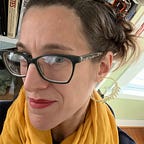Teaching for Black Lives in a (Mostly) White Classroom
--
I am a U.S. history teacher in the United States. I struggle mightily with my use — in the course of my teaching — of collective pronouns: “our country” or “our nation” or “our laws.” The unity suggested by these collective pronouns is challenged by the facts of daily life. We live in segregated neighborhoods, attend segregated schools, live under a political and economic regime in which obscene levels of gender and racial inequality are on persistent and grotesque display. We do not have anything remotely matching the egalitarian premise of a collective pronoun like “our.” So what does that mean for the teaching of Black lives? And particularly, what does it mean to teach for Black lives where I teach, in Lake Oswego, one of the whitest suburbs of already very white Portland?
In my 19-years of teaching I have been asked again and again, how “students in Lake Oswego” receive my curriculum. The subtext of this questions is that curricula foregrounding the lives and histories of people of color is for people of color, not universally applicable or necessary. It is true that representation of people of color and Indigenous Peoples is an immediate life-or-death need for children of color and Indigenous youth in a way that it is not for white kids, whose identities are reflected and validated, minute-by-minute, by almost every sector of U.S. life. But in the long term, if we are interested in building an inclusive and truthful collective identity tied to this land and what has happened here, denying white kids Black history (or that of any other marginalized group) is just as deadly, precisely because it reinforces the lie of white supremacy.
The book, Teaching for Black Lives, edited by Dyan Watson, Wayne Au and Jesse Hagopian, includes the brilliant James Baldwin essay, “A Talk to Teachers.” In it, he explains why Black history liberates all students. He explains:
If, for example, one managed to change the curriculum in all the schools so that Negroes learned more about themselves and their real contributions to this culture, you would be liberating not only Negroes, you’d be liberating white people who know nothing about their own history. . .if you are compelled to lie about one aspect of anybody’s history, you must lie about it all.
Baldwin says it clearly: curriculum bereft of Black lives is a lie, a falsehood too long indulged and too dangerous to ignore.
The stakes are not abstract. All around us is the evidence of our failure to identify and stand in solidarity with each other, all around us are tributes to our morally bankrupt capacity to cordon off ourselves from other people’s pain — the homeless, the incarcerated, the undocumented, the addicted. This failure to identify with others, across difference, is reinforced by a curricula that does not tell the truth about our collective, shared history, a history, to use Baldwin’s words again, that is both beautiful and terrible.
U.S. history without Black lives is mythology. The 13 colonies without Black lives is mythology. The Declaration of Independence, the Revolutionary War, those hot, stuffy weeks in Philadelphia in the summer of 1787 without Black lives is mythology. Abolitionism, the Civil War, and the Union victory in 1865 without Black lives is mythology. There is no U.S. history without Black history, just as there is no U.S. history without women, Indigenous People, immigrants, and the poor. Yet too often our curriculum treats these groups as inconvenient interruptions to an otherwise clear-cut story of forward political and economic progress. Too often our textbooks and lessons place white wealthy men on stage, leaving our students to consult the back of their programs for the fine print of who built the set, ran the lights, sewed the costumes, and wrote the script; and nowhere to be found? Those who refused the narrative altogether — Indigenous nations fighting to maintain sovereignty; revolutionaries building something entirely new.
The collective pronouns that pepper “our” historical language must recognize Indigenous Peoples, Black, Latinx, Asian American people, immigrants, LGBTQ+ people, and women as constitutive of, not peripheral to, history.
By writing and teaching a curriculum that affirms Black lives, I am affirming my belief in the possibility of creating a collective identity rooted in the truth about our past and present; I am affirming the radical possibility of solidarity.
